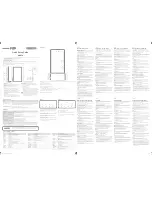
2-10
INSTALLATION
ORBAN MODEL
carriers) above 23 kHz. Below 5 kHz, sensitivity rolls off at 6 dB/octave to
suppress hum that might otherwise be introduced into the subcarrier in-
puts, which are unbalanced.
The subcarrier inputs are mixed into the 8500S’s composite output in the
analog domain, after D/A conversion of the 8500S stereo encoder’s out-
put.
Rear-panel accessible PC-board-mounted trim pots allow the user to
adjust the sensitivities of the two SCA inputs from <100 mV p-p to >10 V
p-p to produce 10% injection with respect to 100% modulation = 4 V p-p
at the 8500S’s composite outputs. (The factory setting is 4 V p-p to pro-
duce 10% injection.)
As shipped from the factory, the second SCA connector emits a
stereo pilot tone
reference
for RDS or RBDS subcarrier generators. If you wish to reconfigure it to ac-
cept an SCA signal, move the link on jumper J6 (on the Composite/SCA daughter-
board) from pins 3 and 4 to pins 1 and 2.
To access J6, remove the 8500S’s top cover according to the instructions
in step 1 on page 4-2. The schematic showing J6 is on page 6-38.
Connect your subcarrier generator(s) to the 8500S’s subcarrier input(s) with coaxial
cable terminated with BNC connectors.
The subcarrier inputs have greater than 600
Ω
load impedance and are
unbalanced. The sensitivity of both inputs is user-adjustable from <100
mV p-p to >10 V p-p to produce 10% injection with respect to 100%
modulation = 4 V p-p at the 8500S’s composite outputs. (The factory set-
ting is 4 V p-p to produce 10% injection.)
VR1 and VR2 on the Composite/SCA daughterboard set the sensitivity of
SCA1 IN and SCA2 IN respectively and are accessible on the rear panel.
You can use the
19K
R
EF
control in
Setup
to determine whether the 19 kHz pilot ref-
erence output will be in-phase (
0
DEG
) with the pilot tone present in the composite
output or will lead it by 90 degrees (
90
DEG
).
0
DEG
is correct for most installations.
Use
90
DEG
only if your RDS/RBDS generator’s 19 kHz reference input specifically re-
quires this phase relationship.
Wordclock/10 MHz Sync Reference
The sync reference input accepts a 1x 5V p-p squarewave wordclock signal or a
10 MHz sinewave or squarewave signal, 0.5 to 5 V peak. A menu item allows you to
synchronize the output sample frequency to the frequency present at the sync. The
connector is a female BNC with the shell grounded to chassis.
To permit daisy-chaining sync signals, the input impedance is greater than 1 K
Ω
. If
the 8500S is the last device driven by the sync coaxial cable, you should terminate it
by using a BNC Tee connector and a 75
Ω
BNC terminator. This will prevent perform-
ance-degrading reflections in the cable. This is required for both wordclock and
AES11id operation.
WARNING: Do not apply an AES3 or AES3id signal to this input.
Doing so will even-
tually cause your Optimod to suffer a “communications board error.”
Summary of Contents for OPTIMOD-FM 8500S
Page 1: ...Operating Manual OPTIMOD FM 8500S Digital Audio Processor Version 1 0 Software...
Page 7: ...Operating Manual OPTIMOD FM 8500S Digital Audio Processor Version 1 0 Software...
Page 26: ......
Page 56: ......
Page 164: ......
Page 308: ......
Page 310: ...6 28 TECHNICAL DATA ORBAN MODEL 8500S CONTROL BOARD PARTS LOCATOR...
















































